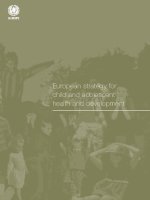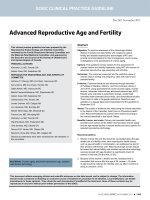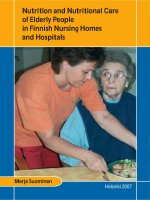Antibiotic Discovery and Development pptx
Bạn đang xem bản rút gọn của tài liệu. Xem và tải ngay bản đầy đủ của tài liệu tại đây (17.55 MB, 1,145 trang )
Antibiotic Discovery and Development
Thomas J. Dougherty
●
Michael J. Pucci
Editors
Antibiotic Discovery
and Development
Editors
Thomas J. Dougherty
Senior Principal Scientist
AstraZeneca Pharmaceuticals LP
35 Gatehouse Dr.
Waltham, MA, USA
Michael J. Pucci
Executive Director
Achillion Pharmaceuticals
New Haven, CT, USA
ISBN 978-1-4614-1399-8 e-ISBN 978-1-4614-1400-1
DOI 10.1007/978-1-4614-1400-1
Springer New York Dordrecht Heidelberg London
Library of Congress Control Number: 2011941801
© Springer Science+Business Media, LLC 2012
All rights reserved. This work may not be translated or copied in whole or in part without the written
permission of the publisher (Springer Science+Business Media, LLC, 233 Spring Street, New York,
NY 10013, USA), except for brief excerpts in connection with reviews or scholarly analysis. Use in
connection with any form of information storage and retrieval, electronic adaptation, computer software,
or by similar or dissimilar methodology now known or hereafter developed is forbidden.
The use in this publication of trade names, trademarks, service marks, and similar terms, even if they
are not identifi ed as such, is not to be taken as an expression of opinion as to whether or not they are
subject to proprietary rights.
While the advice and information in this book are believed to be true and accurate at the date of going to
press, neither the authors nor the editors nor the publisher can accept any legal responsibility for any
errors or omissions that may be made. The publisher makes no warranty, express or implied, with respect
to the material contained herein.
Printed on acid-free paper
Springer is part of Springer Science+Business Media (www.springer.com)
v
Foreword
A strong case can be made that up to this point among the most important scientifi c
achievements in history has been the discovery and development of antibiotics to
treat bacterial infections. During most of human history, the number one cause of
death was infection. The leading killer in the pre-antibiotic era was essentially con-
quered by the advent of antibiotics and average human lifespan increased dramati-
cally. Most of us do not concern ourselves to a great extent with bacterial infections
that would have terrifi ed people less than one hundred years ago. Bacterial diseases
have altered history from pneumococcal pneumonia to bubonic plague to tuberculo-
sis all killing untold millions in their process. In the last century, an assortment of
pills and injections has often turned the tide in the favor of the infected host and
vanquished the pathogen. Sometimes it is diffi cult to recall just how grim infectious
diseases were prior to introduction of antibiotics. As Lewis Thomas put it in his
book The Youngest Science: Notes of a Medicine Watcher [1]: “For most of the
infectious diseases on the wards of Boston City Hospital in 1937, there was nothing
that could be done beyond bed rest and good nursing care.” He notes that with the
introduction of the fi rst antibiotics “The phenomenon was almost beyond belief.
Here were moribund patients, who would surely have died without treatment,
improving within a matter of hours and feeling entirely well within the next day.”
The arrivals of these “wonder drugs” also signaled the rise of the pharmaceutical
industry and have been lucrative products for these companies, remaining a 30 bil-
lion dollar business today. However, unlike most other therapeutic areas, antibiotics
essentially have built-in obsolescence, as pathogens have become resistant both
through mutations and through a number of often clever genetic exchange mecha-
nisms. Drug resistant bacteria are on the rise, and in some cases, the options for
effective treatment are very narrow. Healthcare-associated infections are at the fore-
front of resistance problems, with multiply resistant pathogens that are increasingly
problematic to eradicate with current therapy. Further, resistant infections have
escaped the hospital. In the US, MRSA infects >94,000 and kills >19,000/year., a
toll that exceeds deaths due to AIDS. Antibiotics are also unusual because there is a
societal aspect to their use. Unlike most other disease treatments, the use or misuse
vi
Foreword
of an antibiotic has a much broader impact on individuals beyond the immediate
patient. The loss of effectiveness, due to the spread of resistance impacts all of us.
Thus far, in most cases, humans have been able to keep ahead of the rapidly
evolving resistant microbes. However, the question remains very much open whether
this will continue indefi nitely or whether will we fi nd ourselves heading back
towards pre-antibiotic times. The IDSA issued their “Bad Bugs, No Drugs” report
in 2004 [2], outlining the critical nature of the situation and the urgent need for new
antibiotics to address multiply resistant pathogens. More recently, they have issued
their ten new drugs by 2020 initiative [3], which spans across many key stakeholder
groups. However, during the 1990s and 2000s, several large pharmaceutical compa-
nies either eliminated or downsized their antibacterial discovery efforts. At the same
time and partly as a consequence, the number of newly marketed antibacterial drugs
has also fallen. Some smaller companies have entered into this area, but the number
of researchers trained in antibiotic discovery and development has greatly reduced
as compared to the peak levels in the last century. At a time when the medical need
for new antibiotics is increasing, there is less effort and fewer people trained and
committed to the task.
While there are already many excellent texts that list the various antibiotic classes
and their properties or explore mechanisms of action or mechanisms of resistance,
the goals we set out to achieve in this book are different. Our aim was to provide the
reader with a broad-based yet in depth perspective of the fi eld of discovering and
developing antibiotics. We asked ourselves the following question: what knowledge
would be important for a newcomer to the fi eld? What would a seasoned antibiotic
drug hunter also fi nd useful to have at hand? These were the questions we sought to
address in assembling the overall book outline and recruiting expert chapter authors.
In this volume, the intention is to attempt to capture the antibiotic discovery and
development process and provide the reader with a sense of how it is done and
where things stand in 2011.
The book begins with a solid historical review of the early years of antibiotic
discovery & development (often referred to as “The Golden Years”). It is important
to appreciate the early efforts and techniques employed to fi nd new antibiotics in the
mid-twentieth century. Many readers may fi nd themselves surprised at the sophisti-
cation of screening methods employed 30 or 40 years ago. From that starting point,
the book highlights the evolution of many of the individual classes of drugs in clini-
cal use discovered during that time. In addition, there has been considerable effort
recently to rejuvenate existing classes to address specifi c resistance problems, and
these chapters also refl ect that work. As a result, the individual drug chapters span
examples of early compounds right up to the latest developments in each class. In
some cases, separate chapters are presented on the prominent resistance mecha-
nisms to individual drug classes as well as a review of the multi drug resistant effl ux
pumps, which are particularly problematic for Gram-negative bacteria. We also
wanted to devote several chapters to the “worst offenders”; that is problem patho-
gens that are particularly challenging to current antimicrobial therapy. In this con-
text, it is also important to appreciate the vast array of resistance mechanisms that
different microbial pathogens have acquired and adopted.
vii
Foreword
Having set the stage with existing classes of compounds and problematic pathogens,
the next aspect the book addresses is the drug discovery process and areas to be
considered when identifying novel antibiotics. Two rather unique chapters address
the issues of chemical and physical properties identifi ed in current antibiotics and
the challenge of antibiotic penetration through the several membrane barriers
enroute to the target in the bacterial cell. There is also a chapter devoted to the
important area of natural products, a major source of current antibiotic classes and
the future of such efforts. Next, approaches to discovering novel antibiotics is cov-
ered, including genomic identifi cation of targets, principles of enzymatic screening
to identify potential leads, and the use of cell-based screens to identify inhibitors.
The role of both NMR and X-ray structure techniques in identifying inhibitors,
mechanism of action studies, and their utility in refi ning compounds are covered in
two chapters. The chapter on a recent novel antibiotic program, the identifi cation of
an FtsZ cell division inhibitor, is presented as an excellent example of the process of
modern antibiotic discovery.
Equally important to the refi nement of lead interaction with the target and micro-
bial inhibition is the issue of demonstrating effi cacy in model animal infections. In
this chapter, many of the standard animal infection models are described, along with
the type of data generated and its interpretation, and the role of pharmacokinetics
and pharmacodynamic models in infection research are addressed in their own
chapter.
Finally, we round out the topics with a chapter on antibiotic resistance surveil-
lance, an important area for anticipating what future resistance trends may be. There
is also a chapter on the late stage development process for antibiotics; the types of
studies necessary for the Regulatory authorities, and the process of submitting the
documentation to place a new antibiotic on the market.
We were extraordinarily fortunate to have enlisted some of the leading scientists
in the fi eld from both industry and from academia to share their knowledge and
experience. We are profoundly grateful for the encouraging responses we received
from these individuals and their willingness to participate in this effort. The chap-
ters we received were all extremely thoughtful and of high caliber. Without their
contributions, this volume simply would not exist. Our hope is that the reader will
learn and benefi t from the information in this volume and that it will serve as a valu-
able reference source for antibiotic investigators, present and future.
Waltham, MA, USA Thomas J. Dougherty
New Haven, CT, USA Michael J. Pucci
References
1. L Thomas (1995) The youngest science: notes of a medicine-watcher. Penguin, New York
2. er=id&ItemID=5554
3. The 10x20 Intiative: Pursuing a Global Commitment to Develop 10 New Antibacterial Drugs by
2020. Clin Inf Diseases 50: 1081–1083. 2010
ix
Contents
VOLUME I
Part I Introductory History of Antimicrobial Drugs
1 The Early History of Antibiotic Discovery:
Empiricism Ruled 3
Richard J. White
2 Rational Approaches to Antibacterial Discovery:
Pre-Genomic Directed and Phenotypic Screening 33
Lynn L. Silver
Part II Marketed Major Classes of Compounds
3 Beta-Lactam Antibiotics 79
Malcolm G.P. Page
4 Review of the Quinolone Family 119
George A. Jacoby and David C. Hooper
5 Tetracyclines 147
Patricia A. Bradford and C. Hal Jones
6 Macrolides and Ketolides 181
Ze-Qi Xu, Michael T. Flavin, and David A. Eiznhamer
7 Aminoglycosides 229
Eliana S. Armstrong, Corwin F. Kostrub, Robert T. Cass,
Heinz E. Moser, Alisa W. Serio, and George H. Miller
8 Oxazolidinone Antibacterial Agents 271
Michael R. Barbachyn
x
Contents
9 Glycopeptides and Lipoglycopeptides 301
F.F. Arhin, A. Belley, A. Rafai Far, D. Lehoux, G. Moeck,
and T.R. Parr Jr.
Part III The Rise of Antibiotic Resistance/Resistance
Mechanisms to Major Classes
10 Effl ux-Mediated Antimicrobial Resistance 349
Keith Poole
11 Structural Mechanisms of b-Lactam Antibiotic Resistance
in Penicillin-Binding Proteins 397
Robert A. Nicholas and Christopher Davies
12 Evolution of b-Lactamases: Past, Present, and Future 427
Karen Bush
13 Inducible Resistance to Macrolide Antibiotics 455
Sai Lakshmi Subramanian, Haripriya Ramu,
and Alexander S. Mankin
14 Fluoroquinolone Resistance: Mechanisms,
Restrictive Dosing, and Anti-Mutant Screening
Strategies for New Compounds 485
Karl Drlica, Xilin Zhao, Muhammad Malik, Tal Salz,
and Robert Kerns
15 Glycopeptide Resistance 515
Bruno Périchon and Patrice Courvalin
16 Acquired Tetracycline Resistance Genes 543
Marilyn C. Roberts
Part IV Clinical Issues of Resistance: “Worst Offenders”
List of Problematic Microbes Gram-positives
17 Evolution of Molecular Techniques for the Characterization
of MRSA Clones 571
Duarte C. Oliveira, Hermínia de Lencastre,
and Alexander Tomasz
18 Mechanisms of Penicillin Resistance
in Streptococcus pneumoniae: Targets, Gene Transfer
and Mutations 593
Regine Hakenbeck, Dalia Denapaite, and Patrick Maurer
19 Clinical Aspects of Multi-Drug Resistant Enterococci 617
German A. Contreras and Cesar A. Arias
xi
Contents
Part V Gram-negatives
20 Clinical Issues of Resistance: Problematic Microbes:
Enterobacteriaceae 651
David F. Briceño, Julián A. Torres, José D. Tafur,
John P. Quinn, and María V. Villegas
21 Pseudomonas aeruginosa: A Persistent Pathogen
in Cystic Fibrosis and Hospital-Associated Infections 679
Kristen N. Schurek, Elena B.M. Breidenstein,
and Robert E.W. Hancock
Part VI Mycobacteria
22 Drug Resistant and Persistent Tuberculosis:
Mechanisms and Drug Development 719
Ying Zhang
VOLUME II
Part VII Antibiotic Discovery
23 Resistance Trends and Susceptibility Profi les
in the US Among Prevalent Clinical Pathogens:
Lessons from Surveillance 753
Chris Pillar and Dan Sahm
24 Chemical Properties of Antimicrobials
and Their Uniqueness 793
Mark J. Macielag
25 Natural Products in the 21st Century 821
Sheo B. Singh
26 Permeability of Bacteria to Antibacterial Agents 849
Wright W. Nichols
27 Novel Antibacterial Targets/Identifi cation of New Targets
by Comparative Genomics 881
Sarah M. McLeod, Thomas J. Dougherty,
and Michael J. Pucci
28 Cell-Based Screening in Antibacterial Discovery 901
Scott D. Mills and Thomas J. Dougherty
29 Enzyme-Based Screens in HTS 931
David E. Ehmann and Stewart L. Fisher
xii
Contents
30 Antibacterial Inhibitors of the Essential Cell
Division Protein FtsZ 957
Lloyd G. Czaplewski, Neil R. Stokes, Steve Ruston,
and David J. Haydon
31 Structure-Guided Discovery of New Antimicrobial Agents 969
Molly B. Schmid
32 NMR in Infection Research 985
Jun Hu and Gunther Kern
33 A Review of Animal Models Used for Antibiotic Evaluation 1009
Andrea Marra
34 In Vivo Pharmacodynamic Modeling for Drug Discovery 1035
Jared L. Crandon and David P. Nicolau
35 Applications of Pharmacokinetic/Pharmacodynamic
Models for the Development of Antimicrobial Agents 1055
April Barbour and Hartmut Derendorf
Part VIII Antibiotic Drug Development
36 Antibiotic Drug Development: Moving Forward
into the Clinic 1071
Jane E. Ambler and Greg G. Stone
Part IX The Economics and Incentives of Antibiotic Drug Discovery
37 Stimulating Antibacterial Research and Development:
Sense and Sensibility? 1103
Steven J. Projan
Index 1107
xiii
Contributors
Jane E. Ambler AstraZeneca Pharmaceuticals , 35 Gatehouse Drive, Waltham ,
MA 02451, USA
F. F. Arhin The Medicines Company , 7170 Frederick Banting Street, 2nd Floor,
Saint Laurent, Québec , H4S 2A1 Canada
Cesar A. Arias Division of Infectious Diseases , University of Texas Medical
School at Houston , 6431 Fannin MSB 2.112, Houston , TX 77030, USA
Eliana S. Armstrong Achaogen, Inc. , 7000 Shoreline Court, Suite 372,
South San Francisco , CA 94080, USA
Michael R. Barbachyn AstraZeneca Pharmaceuticals , 35 Gatehouse Drive,
Waltham , MA 02451, USA
April Barbour GlaxoSmithKline , 709 Swedeland Rd, Mailstop UW2350,
King of Prussia , PA 19406, USA
Adam Belley The Medicines Company , 7170 Frederick Banting Street, 2nd Floor
Saint Laurent , Québec , H4S 2A1, Canada
Patricia A. Bradford Wyeth Research , 401 N. Middletown Road, Pearl River ,
NY 10965, USA
Elena B. Breidenstein Centre for Microbial Diseases and Immunity Research ,
University of British Columbia , 232-2259 Lower Mall, V6T1Z4 , Vancouver ,
BC , Canada
David F. Briceno International Center for Medical Research & Training (CIDEIM) ,
Cali , Colombia
Karen Bush Department of Biology, Jordan Hall A311 , Indiana University ,
Bloomington , IN 47401, USA
Robert T. Cass Achaogen, Inc. , 7000 Shoreline Court, Suite 372, South San
Francisco , CA 94080, USA
xiv
Contributors
German A. Contreras Division of Pediatrics Infectious Diseases , University of
Texas Medical School at Houston , 6431 Fannin Street, MSB 3.001 Houston ,
TX 77030, USA
Patrice Courvalin Institut Pasteur, Unité des Agents Antibactériens , 25, rue du
Docteur Roux, 75724 Cedex 15 , Paris, France
Jared L. Crandon Center for Anti-Infective Research and Development ,
Division of Infectious Diseases , 80 Seymour Street, Hartford Hospital, Hartford ,
CT 06102, USA
Lloyd G. Czaplewski Prolysis Ltd. , Begbroke Science Park, Sandy Lane, Yarnton ,
Oxfordshire , OX5 1PF , UK
Christopher Davies Department of Biochemistry and Molecular Biology , Medical
University of South Carolina , 173 Ashley Avenue, Charleston , SC 29425, USA
Herminia DeLancastre Laboratory of Microbiology , The Rockefeller University ,
New York , NY 10065, USA
Dalia Denapaite Department of Microbiology , University of Kaiserslautern,
Kaiserslautern , D-67663, Germany
Hartmut Derendorf Department of Pharmaceutics, College of Pharmacy ,
University of Florida , 1600 SW Archer Rd, Room P3-20 , PO Box 100494 , Gainesville ,
FL 32610, USA
Thomas J. Dougherty AstraZeneca Pharmaceuticals , 35 Gatehouse Drive, Waltham ,
MA 02451, USA
Karl Drlica Public Health Research Institute , New Jersey Medical School,
UMDNJ , 225 Warren Street, Newark , NJ 07103, USA
David E. Ehmann AstraZeneca Pharmaceuticals , 35 Gatehouse Drive, Waltham ,
MA 02451, USA
David A. Eiznhamer Advanced Life Sciences , 1440 Davey Road, Woodridge ,
IL 60517 , USA
Adel Rafai Far The Medicines Company , 7170 Frederick Banting Street, 2nd
Floor Saint Laurent , Québec , H4S 2A1, Canada
Stewart L. Fisher AstraZeneca Pharmaceuticals , 35 Gatehouse Drive Waltham ,
MA 02451, USA
Michael T. Flavin Advanced Life Sciences , 1440 Davey Road Woodridge ,
IL 60517, USA
Regine Hakenbeck Department of Microbiology , University of Kaiserslautern ,
Kaiserslautern D-67663, Germany
Robert E. Hancock
Centre for Microbial Diseases and Immunity Research ,
University of British Columbia , 232-2259 Lower Mall V6T1Z4 , Vancouver
BC , Canada
xv
Contributors
David J. Haydon Prolysis Ltd , Begbroke Science Park Sandy Lane, Yarnton
Oxfordshire OX5 1PF , UK
David C. Hooper Division of Infectious Diseases , Massachusetts General Hospital ,
55 Fruit Street Boston , MA 02114, USA
J u n H u AstraZeneca Pharmaceuticals , 35 Gatehouse Drive Waltham , MA
02451, USA
George A. Jacoby Lahey Clinic , 41 Mall Road Burlington , MA 01805, USA
C. Hal Jones Wyeth Research , 401 N. Middletown Road, Pearl River , NY
10965, USA
Gunther Kern AstraZeneca Pharmaceuticals , 35 Gatehouse Drive, Waltham , MA
02451, USA
Robert J. Kerns Public Health Research Institute , New Jersey Medical School,
UMDNJ , 225 Warren Street, Newark , NJ 07103, USA
Corwin F. Kostrub Achaogen, Inc. , 7000 Shoreline Court, Suite 372 South San
Francisco , CA 94080, USA
Dario Lehoux The Medicines Company , 7170 Frederick Banting Street, 2nd Floor
Saint Laurent , Québec , H4S 2A1, Canada
Mark Macielag Johnson & Johnson Pharmaceutical Research & Development ,
776 Welsh & McKean Roads Spring House , Pennsylvania , 19477-0776, USA
Muhammed Malik Public Health Research Institute , New Jersey Medical School,
UMDNJ , 225 Warren Street, Newark , NJ 07103, USA
Alexander S. Mankin Cntr. Pharm.Biotech. – m/c 870 , University of Illinois , 900
S. Ashland Ave., Rm. 3052, Chicago , IL 60607, USA
Andrea Marra Rib-X Pharmaceuticals, Inc. , 300 George Street Suite 301
New Haven , CT 06511, USA
Patrick Maurer Department of Microbiology , University of Kaiserslautern , Paul
Ehrlich Str. 23 , Kaiserslautern , D-67663, Germany
Sarah M. McLeod AstraZeneca Pharmaceuticals , 35 Gatehouse Drive Waltham ,
MA 02451, USA
George H. Miller Achaogen Inc. , 7000 Shoreline Court, Suite 372 South San
Francisco , CA 94080, USA
Scott Mills AstraZeneca Pharmaceuticals , 35 Gatehouse Drive Waltham , MA
02451, USA
Greg Moeck
The Medicines Company , 7170 Frederick Banting Street, 2nd Floor
Saint Laurent , Québec , H4S 2A1, Canada
Heinz E. Moser Achaogen Inc. , 7000 Shoreline Court, Suite 372 South San
Francisco , CA 94080, USA
xvi
Contributors
Robert A. Nicholas Department of Pharmacology , University of North Carolina ,
Chapel Hill , North Carolina , 27599, USA
Wright W. Nichols AstraZeneca Pharmaceuticals , 35 Gatehouse Drive Waltham ,
MA 02451, USA
David P. Nicolau Center for Anti-Infective Research and Development Hartford
Hospital , 80 Seymour Street Hartford , CT 06102, USA
Duarte Oliveira Laboratory of Molecular Genetics Instituto de Tecnologia
Química e Biológica , Universidade Nova de Lisboa , Oeiras , Portugal
Malcolm G. P. Page Basilea Pharmaceutica International Ltd. , 3255 CH-4005 ,
Basel , Switzerland
Thomas R. Parr Jr The Medicines Company , 7170 Frederick Banting Street, 2nd
Floor Saint Laurent , Québec , H4S 2A1, Canada
Bruno Perichon Institut Pasteur, Unité des Agents Antibactériens , 28 Rue du
Docteur Roux , 75724 Cedex 15 , Paris, France
Chris M. Pillar 14100 Park Meadow Drive , Eurofi ns Medinet, Inc. Herndon ,
VA 20171, USA
Keith Poole Department of Microbiology and Immunology , Queen’s University ,
Kingston , ON K7L 3N6, Canada
Steven J. Projan MedImmune One MedImmune Way , Gaithersburg , MD
20878, USA
Michael J. Pucci Achillion Pharmaceuticals, Inc. , 300 George Street New Haven ,
CT 06511, USA
John P. Quinn P fi zer Global Research and Development , Groton , CT 06340, USA
Haripriya Ramu Center for Pharmaceutical Biotechnology , University of Illinois ,
900 South Ashland Avenue Chicago , IL 60607, USA
Marilyn C. Roberts Department of Environmental and Occupational Health
Sciences School of Public Health , University of Washington , Seattle , WA
98195, USA
Steve Ruston Prolysis Ltd. , Begbroke Science Park Sandy Lane, Yarnton
Oxfordshire, OX5 1PF , UK
Daniel F. Sahm Eurofi ns Medinet, Inc. , 14100 Park Meadow Drive Herndon ,
VA 20171, USA
Tal Salz Public Health Research Institute New Jersey Medical School, UMDNJ ,
225 Warren Street Newark , NJ 07103, USA
Kristen N. Schurek
Centre for Microbial Diseases & Immunity Research ,
University of British Columbia , 2259 Lower Mall Vancouver British Columbia ,
V6T 1Z4, Canada
xvii
Contributors
Molly B. Schmid Keck Graduate Institute , 535 Watson Drive Claremont , CA
91711, USA
Lynn Silver LL Silver Consulting, LLC , 955 S. Springfi eld Ave., Unit C403
Springfi eld , NJ 07081, USA
Sheo B. Singh Merck Research Laboratories , Rahway , NJ 07065, USA
Neil R. Stokes Prolysis Ltd. , Begbroke Science Park Sandy Lane, Yarnton
Oxfordshire, OX5 1PF , UK
Gregory G. Stone AstraZeneca Pharmaceuticals , 35 Gatehouse Drive Waltham ,
MA 02451, USA
Sai Lakshmi Subramanian Center for Pharmaceutical Biotechnology , University
of Illinois , 900 South Ashland Avenue Chicago , IL 60607, USA
Jose D. Tafur International Center for Medical Research and Training (CIDEIM) ,
Cali , Colombia
Alexander Tomasz Laboratory of Microbiology , The Rockefeller University ,
New York , NY 10065, USA
Julian A. Torres International Center for Medical Research and Training
(CIDEIM) , Cali , Colombia
Maria V. Villegas International Center for Medical Research and Training
(CIDEIM) , Cali , Colombia
Richard J. White Half Moon Bay Biotechnology Consulting , Half Moon Bay , CA
94019 , USA
Ze-Qi Xu Advanced Life Sciences, Inc. , Woodridge , IL 60517, USA
Ying Zhang Department of Molecular Microbiology and Immunology Bloomberg
School of Public Health , Johns Hopkins University , Baltimore , MD 21205, USA
Xilin Zhao Public Health Research Institute , New Jersey Medical School, UMDNJ ,
225 Warren Street Newark , NJ 07103, USA
Part I
Introductory History
of Antimicrobial Drugs
3
T.J. Dougherty and M.J. Pucci (eds.), Antibiotic Discovery and Development,
DOI 10.1007/978-1-4614-1400-1_1, © Springer Science+Business Media, LLC 2012
1.1 Introduction
For the last 60 or so years the chemotherapy of bacterial infections has been domi-
nated by natural products and their semi-synthetic variants. Although the term anti-
biotic was initially used exclusively to describe those anti-bacterials of natural or
semi-synthetic origin, it has become broadened in common usage to include antibac-
terial agents of purely synthetic origin as well. The emphasis of this chapter will be
on the discovery of novel prototype structures that represent the different classes of
antibiotic e.g. penicillins, cephalosporins, and macrolides a distinct from the multi-
ple generations of improved analogues within a class that have typically followed an
initial discovery. In some cases, the prototypical molecule discovered was developed
and marketed without modifi cation. In others, some modifi cation proved necessary
to make the drug clinically useful. An antibiotic class is defi ned by a characteristic
core moiety, or pharmacophore, that is responsible for the observed antibacterial
activity. Although dramatic and important improvements have been made through
the chemical manipulation of the molecule that was fi rst found, from the discovery
standpoint, they represent variations on a pre-existing theme. An important consid-
eration in this chapter will focus on the discovers’ mindset and what led him/her to
fi nd a new antibiotic. Unfortunately such details are not always reported, and, at best,
the information available is fragmentary. In some cases, comprehensive accounts of
the events leading up to the discovery are well-documented, in others, however, only
a minimal description is available. The extent of the information reported herein
does not necessarily refl ect the relative importance of individual discoveries, but
simply what is readily accessible. In addition to the results published in scientifi c
R.J. White, D. Phil., B. Sc (*)
HMB Biotechnology Consulting , 132 Spyglass Lane ,
Half Moon Bay , CA 94019, USA
e-mail:
Chapter 1
The Early History of Antibiotic Discovery:
Empiricism Ruled
Richard J. White
4
R.J. White
journals, several books have been written that touch on antibiotic discovery [ 8, 31,
35, 57, 62 ] and have proven to be an invaluable resource in compiling this chapter.
The fi rst publication documenting an antibiotic’s in vitro and/or in vivo activity will
usually be considered to be the year of its discovery. Only those antibiotics that were
found to have clinical utility and were, for at least a time, marketed for the treatment
of systemic bacterial infections will be considered. As will become clear, the gap in
time between an antibiotic’s discovery and its availability to prescribing physicians
has increased dramatically over the years. This is largely a result of the burgeoning
number of regulatory hurdles that have to be overcome. In turn, this is the outcome
of an improved understanding of the different factors affecting safety and effi cacy,
coupled with the need to show that any novel antibiotic was at least as good as, if not
better, than the standard of treatment available at the time. This chapter on the early
history of discovery will only cover those classes of antibiotic found by the use of
empirical screening methods, which in reality represents the majority. A subsequent
chapter will cover those antibiotics that were discovered more recently by employing
rational approaches. The transition from the historically successful empirical
approach to that of a more rational screening approach was gradual with signifi cant
overlap occurring over a number of years starting in the late 1970s. In fact, the two
most recent novel antibiotic classes to be launched in the fi rst decade of the twentieth
century (linezolid and daptomycin) were discovered empirically! The order in which
the various antibiotic prototypes will be discussed is not strictly chronological
because there were two tracks or approaches running in parallel: one a synthetic
chemicals based approach and the other exploiting natural products. For conve-
nience, there is some grouping of compounds on the same track. The structures of the
antibiotics discussed in this chapter are shown in the accompanying Figs. 1.1 – 1.4 ,
which are grouped by their provenance. In those cases where the molecule initially
found needed chemical modifi cation to achieve clinical utility, the marketed product
is shown.
1.2 Birth of Chemotherapy
Luis Pasteur and Robert Koch are widely recognized as having played a critical
role in formulating and developing the germ theory of disease; for this and related
work, they were both awarded Nobel prizes. In 1892, Koch’s postulates spelled
out the criteria for proving that a particular bacterium was responsible for a spe-
cifi c disease. Meanwhile, a highly active German chemical dye industry had pro-
vided important reagents to histologists who had shown that some of these dyes
could selectively stain tissues or pathogens. This set the stage for Paul Ehrlich to
propose his concept of selective chemotherapy. He reasoned that it should be pos-
sible to create ‘magic bullets’ that would not just stain a pathogen, but selectively
kill it as well.
5
1 The Early History of Antibiotic Discovery: Empiricism Ruled
1.2.1 Ehrlich’s Discovery of Salvarsan
Ehrlich took a pathogen-targeted approach and systematically searched for a drug
active against syphilis, caused by the bacterium Treponema pallidum . His starting
point was atoxyl, an arsenic-containing compound that had some activity against
African sleeping sickness, but had serious toxicity issues. Atoxyl was amenable to chem-
ical modifi cation and became the lead on which to base a chemical optimization
Fig. 1.1 Antibiotics produced through synthetic chemistry
6
R.J. White
program. He reasoned that although arsenic itself was known to be toxic, that an
organo-arsenic derivative might become selectively toxic to a pathogen. This effort
eventually led to the synthesis of analogue number 606, subsequently named
Salvarsan, which cured syphilis infections in a rabbit model [ 66 ] . It is interesting to
note that all the activity screening had out be carried out with an in vivo rabbit
model since there was no in vitro test system available, which is still the case today.
The drug was discovered in 1909 and amazingly (by today’s standards) was in clini-
cal use by the following year. It was extremely successful in treating syphilis, espe-
cially when compared with standard treatment of the day, Mercury salts. It provided
Hoechst with the fi rst blockbuster drug. Prior to the discovery of Salvarsan, Ehrlich
was awarded the Nobel Prize for his work on immunology in 1908. Despite the
important role that Salvarsan has played historically in the therapy of bacterial
infections, its actual structure was controversial. In 2005, it was revealed that
Salvarsan is actually a mixture of arsenic bonded species, which slowly gives rise to
an oxidized species that is responsible for the activity against the pathogen [ 41 ] .
1.2.2 Prontosil: Forerunner of the Sulfonamides
Continuing in the same vein as Ehrlich, Gerhard Domagjk of the Bayer Division of
IG Farben (a consortium of German dye manufacturers) started testing azo related
dyes for activity against bacteria. The program started in 1927, and in 1932 KI-730
(subsequently named Prontosil) was submitted for testing; it was devoid of activity
in vitro but was still tested in vivo using a Streptococcus pyogenes infection in mice
[ 62 ] . Surprisingly, it worked very well in vivo and its discovery was announced
in 1935 [ 18 ] . As is often the case when news of a novel antibacterial leaked out,
Fig. 1.2 Antibiotics produced by Fungi
7
1 The Early History of Antibiotic Discovery: Empiricism Ruled
Fig . 1.3 Antibiotics produced by non-actinomycete bacteria
several other groups began work on analogues, and it was quickly recognized that
Prontosil consisted of two moieties: a triamino benzene imparting the red color, plus
a p-aminobenzene sulfonamide, which turned out to be the active part of the mole-
cule. This knowledge led to the synthesis of a large number of active sulfonamides,
and representatives of this class are still on the market today. Unlike Prontosil, they
were active in vitro as well as in vivo. In 1940, it was recognized that the sulfon-
amides could be reversed by p-aminobenzoic acid; the sulfonamides are structural
analogues of this natural metabolite [ 73 ] . For the fi rst time, chemists had the benefi t
of starting with a molecule that was not intrinsically toxic, until this point, much of
the efforts to discover novel antibacterials started off with a toxic molecule and tried
to engineer out the toxicity (e.g., salvarsan).









